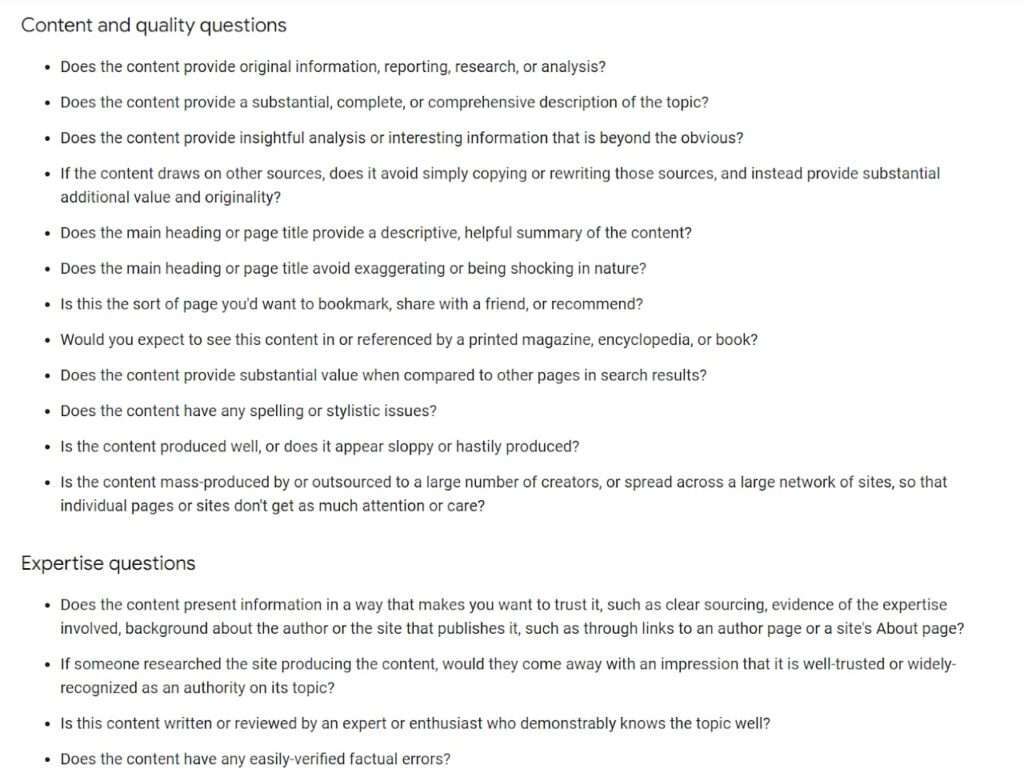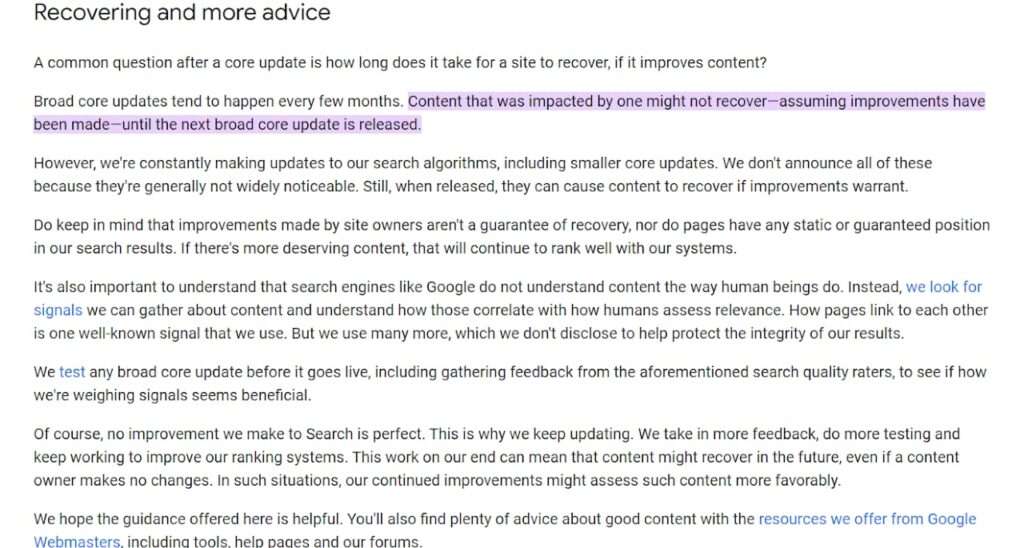Today when everyone strives hard to get noticed, a sudden drop in visibility is extremely frustrating and annoying after Google’s core updates.
Visibility is the lifeblood of any online presence and as you know Google Master is emerging day by day with new strategies it becomes crucial to stay updated and improve the SEO strategies according to it.
Sometimes Google really shakes up the things leaving the marketers and bloggers scratching their heads.
Take the example of the 2019 BERT update that leads to a significant decrease in the ranking of many major sites.
The bad news is Google updates usually come with any specific warning and indication. So to cope with this situation and prevent a major loss I’ve made a comprehensive guide to show you how to tackle it.
While the recent March 2024 updates was disclosed on 5 March, here’s a strategic approach to website recovery for SEO professionals.
I will walk you through each step so you can have a clear idea of what to do and how to do it.
What is Google’s Algorithm?
A Google algorithm is the fancy used by the system to show how the pages will likely be ranked in search results.
200+ factors come under this complex system Google algorithm and it’s too difficult to understand how the algorithm works.
The twist is these factors are constantly changing sometimes even without them aren’t noticeable.
They completely work behind the scenes leaving the website owners in shock and wondering why the ranking dropped suddenly.
Google depends on “core updates” to improve the user experience. You also might be familiar with Google Panda and Penguin they are the essential elements of search engines.
The Greatest Myth:
The great misconception about the Google updates is you always face a drop in ranking whenever the algorithm changes.
But it is not true. You might encounter ups and downs after the Google core update but some websites even saw an improvement in ranking.
The only aim of the core updatse is to improve the search engine and make it more user-friendly.
If your site is producing high-quality content consistently that resonates with user intent it could see a positive outcome after an updates.
TimeLine of Recent Google Updates:
March 2024 spam update– started on 5 March and completed in 14 days, 21 hours.
2023
November 2023 reviews update– started on 8 November and completed in 29 days.
November 2023 core update– started on 2 Nov 2023 and completed in 25 days and 21 hours.
October 2023 core update– started on 5 Oct 2023 and completed in 13 days, 23 hours.
5 March 20224 Core Updates:
Firstly let’s talk about the recent Google core update on 5 March which is clearly intended to remove the unoriginal and low-quality content.
They aim to provide more authentic and relevant content by targeting spammy and clickbait content.
So the website producing high-quality content might see an improvement in ranking but those producing low-quality content have to buckle up for significant loss.
On 5 March Chris Nelson from Google said “Along with our new spam policies, we are also launching the March 2024 spam updates today. It took almost 15 days to roll out and on 20 March Google wrote the roll out is completed.
The summary of this spam update is comprised of three main policies.
- Expired domain abuse
- Scaled domain abuse
- Site reputation abuse
The March spam updates is completed but still we are expecting some more changes in the spam update. The core update is working so fast so be ready.
Ways to Recover After Google Core Updates:
The very first and most important step is to calm down and not panic if you see a sharp decrease in ranking.
You are not alone many sites face this due to some reason. Take a deep breath and find out what is the reason for this.
Google’s algorithm always updates in one way or another which may result in positive or negative impact.
First, go and check out if any updates are released when your ranking drops on the news “Webmaster Central blog” or maybe other reputable news source.
After that, you have to take a step forward and follow these steps
Step#1. Confirm the Impact:
Track Rankings:
To determine what kind of effect the algorithm made on your site you have to track the site’s ranking.
Use the performance data to find out the areas that need improvement and are not enough optimized for search users. Make sure that every page and post is optimized and user-friendly.
Sometimes people might think that they got penalized by Google and they can do nothing. That’s why tracking the performance is necessary.
Utilize tools like Google Analytics to monitor ranking fluctuations for your target keywords. See how and which specific keywords are losing ranking. A significant drop suggests a potential update impact.
Take a complete round and look for any technical problem that badly affects your online visibility. Technical SEO problems include slow page speed, mobile-friendliness, broken links, and duplicate content.
This helps you to make a list of shortcomings or points that have been impacted.
Google Search Console (GSC):
Google search console is the tool suggested by Google. Put in the URL of your site and analyze the Search Performance report in GSC to pinpoint pages experiencing ranking declines.
It identifies pages with reduced organic traffic and some sort of negative effect.
Your site has more than one page it takes a lot of time to analyze all pages one by one manually. Also, there is the chance of human error. So to avoid this GSC is the coolest option.
Industry Buzz:
Check SEO forums and publications to discuss the update’s effects on similar websites. Look whether other sites have also crashed or only your site has been hit.
By having some open-ended conversation online you can find out how to recover from this loss. This is the most appreciateable method suggested by many experts.
Step#2. Content Quality Audit:
Content quality audit is a process of reviewing your content such as published articles, and blog posts, and landing keenly to see what factor goes against the recent core update.
It helps you to identify the gaps, and areas of improvement and decide on which factors you have to work on.
Usually, marketers conduct surveys two or more times a year and inspect all the pages. But before going for an audit, you must have clear objective goals for what you are trying to gain from this audit.
Here are the main goals you have to consider according to the recent March core updates.
Produce High-Quality Content:
Back in 2011, Google published a post of writing what exactly a quality website looks like, their only goal was to reduce the number of low-quality content by decreasing their ranking.
At that time website owners did not know what factors determine the quality and they have to optimize.
But luckily now after so many years of hard work, marketers have found out and made a complete guide on how to deal with it.
Create content that is original and high-quality with in-depth and insightful information.
Check that your content resonates with the search intent and has SEO titles and descriptions. Make sure that your content is concise yet comprehensive.
As Google Danny Sullivan says,
Write as short as they want not in a way they think Google wants because we don’t want people doing things for Google.
This makes sense. You don’t want to read 1500+ words answer. Right?
It also emphasizes that Google always prioritizes content evenly matches with search queries.
Expertise, Authoritativeness, and Trustworthiness (E-A-T) analyze if the content demonstrates expertise on the topic and comes from a credible source.
Another important keyword to focus on is “keywords”. It is the main driver that carries your content load.
But here is the twist. What?
This is like a chess game. You have to play very smartly.
Use keywords in a way that seems so natural without compromising on quality.
According to BERT, you have to focus more on quality than keywords and it is actually very helpful.
In the SEO community, the thing that has been observed for a very long time is Google’s more toward the user experience by making less important the exact match keywords.
Google John Mueller wrote, ” From my point of view, all these changes that have been happening over the years, they do lead in the direction that you don’t have to have the exact keywords on your pages anymore”.
But Mueller also warns that the algorithm is unintentionally reducing the importance of exact keywords.
So the best practice is to write as just as it always has, stay on the topic, don’t add irrelevant information, cooperate with visuals, comprehensive and easy to understand.
Step#4. Technical SEO Review:
To ensure the website recovery you have to leverage technical SEO and verify that every page is secure both externally and internally.
There are many factors included in technical SEO that you have to focus on for improvement.
Page Load Speed:
Page load speed is one of the crucial improvement factors. It greatly impacts your site ranking.
Users expect to get things faster and it negatively impacts your site if the page is loading slowly.
For example, walmart.com says that for every second increase in the speed of the page, their rate of conversions increases eventually.
In 2017 Google started to pay more serious attention to it and considered this as a vital factor for ranking.
Use SEO tools to ensure your website meets Core Web Vitals standards for fast loading speed, responsiveness, and visual stability. Tools like Google Page Speed Insights can help assess these factors.
verify that your website renders flawless on mobile devices. Because about half of the traffic is made by mobile devices.
Mobile Friendliness:
Mobile friendliness is another crucial factor of technical SEO and signals Google that this site is truly optimized for mobile users.
You have to design the pages in an appealing way, that fits on any screen and allows that user to navigate and search for the content easily.
By optimizing the elements of technical SEO you can improve the website performance, enhance user experience, and ensure the consistent return.
Step#5. Content Optimization:
Content Refresh:
After the Google core updates, if you want to regain visibility consider publishing new and authoritative content.
Update outdated content with fresh information and insights while maintaining its core value.
Here are some useful tips that help you to produce more relevant and insightful content.
- First, analyze your competitor’s content. See what type of content they are producing that helps them to get rank. Additionally, it gives you insights about what content you need to produce and how well you can go.
- Conduct SEO keyword research. Find what keywords are trending in your particular niche and what people are searching for.
- Ask for audience feedback and improve your content according to their need and requirements.
- Build authority and relevance in your content. Focus on creating content that is highly relevant and solves the problem of users. It helps you to boost the conversions and engagement rate.
Step#4. Backlink Audit:
Backlink Profile Analysis:
To recover the loss from Google core update reviewing backlinks is most important. Disavow low-quality backlinks that might negatively impact your website’s authority.
Consider acquiring high-quality backlinks from reputable websites in your niche to build authority.
Use white hat techniques to maintain your backlink profile. Quality inbound links are essential for good placement in search engines.
Ensure the credibility of those linked domains by analyzing the quality link metrics including Domain Authority (DA), Page Authority (PA), Trust Flow (TF), and Citation Flow (CF).
Conduct a thorough audit by utilizing SEO tools of existing backlinks.
Find if any spammy links destroy your backlink profile and find links of outdated content. This way you can update and remove the links that hurt your site ranking.
However, you have to create a good strategy for generating high-quality backlinks.
March Spam Update 2024:
Google Core update of March 2024 mainly is about spam policies. I’ve already mentioned the three major policies released above but the point to note is they are not in action till May 5. Google warns websites to review and audit to prevent the loss of a sudden drop in ranking.
Expire Domain Abuse:
Some website owners invest in expired domains of good reputation just to manipulate search engine ranking without providing any value to the user. They aim to rank their site based on the old reputation of expired domains.
Scale Content Abuse:
When people load their website with a number of pages with the goal of ranking well on Google search but publish both human and AI-generated low-quality content that provides little to no value. The sole purpose is to manipulate search ranking which comes under the term “Spam”.
Site Reputation Abuse:
When third parties publish pages without the involvement of originals and violate policy just to take advantage of their ranking. This is considered as spamming search ranking.
Frequently Asked Questions About Google Updates:
What is the purpose of Google core updates?
Google does not specify any reason to before releasing any update. However, the sole purpose is only to improve search engines and provide the high-quality content most relevant to search queries, reducing spammy content and enhancing the user experience.

How long does it take for the website to recover from a Google update?
Recovery typically depends on how much a website gets affected by updates. However, it may take weeks to months to regain its visibility.
What kind of updates does Google usually roll out?
Google made various updates to make provide first-hand and helpful content based on user behavior. They are targeting to make the search engine a golden dig where everything shines.

How do updates impact website visibility and ranking?
It depends on what type of update is made and how powerful the SEO practices have been done on your site. Updates can either negatively impact by dropping the ranking or positively impact by boosting the ranking and making your site more visible.
Final Thoughts On Google Core Update:
This is the general phenomenon that happens with many website owners, and e-commerce store owners so don’t get tense and think you can do nothing.
If you want to recover from the update you have to make a strategic approach analyze your site algorithm and audit content and backlinks.
Observe what your competitors are doing and what tactics they are applying to regain or boost their site visibility.
By carefully analyzing and following the above 6 steps with patience you can easily regain visibility quickly.
Hope this comprehensive guide helps you recover from Google’s update.
If you have any other useful tips to recover from the Google core update mention it in the comment section below.
